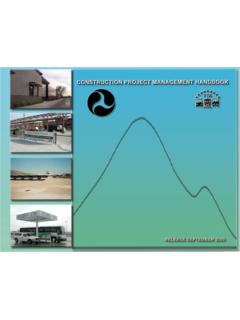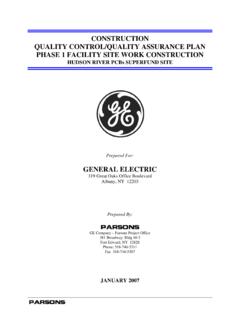Transcription of Introduction to Construction Management - Routledge
1 Introduction to Construction ManagementA Routledge FREEBOOKI ntroduction01: Construction Economics By Danny MyersChapter: An Introduction to the Basic Concepts02: Management of Construction Projects By John E. Schauf elberger, Len HolmChapter: Introduction03: Quantity Surveyor's Pocket Book By Duncan CartlidgeChapter: The quantity surveyor and the Construction industry04: Estimating and Tendering f or Construction By Martin BrookChapter: Introduction05: Building Measurement By Andrew D. PackerChapter: Introduction06: Total Construction Management By John S. Oakland, Marton MarosszekyChapter: Understanding lean constructionYou can discover more of our key Construction property titles on our website here: https:/ / products/ SCBU20 IntroductionIntroduction to Construction Management is a FreeBook brought to you by Routledge , containing a collection of selected chapters f rom six key titles published in the last twelve months.
2 The chapters presented here cover introductions to key topics like project Management , economics, measurement and tendering, all essential f or aspiring Construction students and prof essionals currently studying f or their related qualif ications. We have a wide range of textbooks, ref erences, monographs, and practical guidebooks to serve the needs of students, instructors, and established prof essionals and the contents here represents only a very small sample of that of f ering. Courses in Construction , quantity surveying and building surveying will f ind resources that will be usef ul as required texts and supplementary reading. Here is a selection of representative chapters f rom just six of our recent publications to give you an idea of the quality and variety of subject matter addressed in our portf olio.
3 So, please enjoy this sample f rom available and new textbooks, and consider recommending them to your students, colleagues, and library. 01: Construction EconomicsChapter: An Introduction to the Basic Concepts11 This book is written for students from many backgrounds: architecture, surveying, civil engineering, mechanical engineering, structural engineering, Construction , project or estate Management , property development, conservation and, even, economics. Economics students may find it possible to skip over some of the standard analysis, but should be forewarned that in many ways Construction is quite distinct from other sectors of the economy. An important aim of this text is to draw out these distinctions and clarify the unique nature of the industry.
4 In this first chapter we begin to outline the main characteristics of firms involved in Construction markets, introducing the complexity of the Construction process and diversity of activities. As the chapter develops you will sense that there are a number of possible ways to describe the Construction industry. Table identifies a range of activities that can be included in a broad definition of the industry. By contrast, Table (see page 11) divides the Construction process into a number of professional stages and Table (see page 19) outlines a simple classification system that narrowly defines the industry as firms that just construct and maintain various types of buildings and aim of the text is to demonstrate that underlying the Construction process, from conception to demolition, is a lot of useful economics.
5 As suggested in the preface, economics should not be regarded as solely related to the appraisal of costs. The subject matter is far broader, and this text introduces a number of branches of economic theory. These have been selected to provide fresh insights into the An Introduction to the Basic Concepts1 Suppliers of basic materials, sand, cement, aggregate and bricksManufacturers of site equipment, such as cranes and bulldozersSite operatives who bring together components and materialsProject managers and surveyors who co-ordinate the overall assemblyTable The Construction industry broadly definedManufacturers of building components, windows, doors, pipes and radiatorsArchitects and engineers who design new buildings and infrastructureFacility managers who manage and maintain propertyThe key actors include.
6 Property developers who initiate new projectsProviders of complementary services, such as demolition, disposal and clean-upchapter 1 fourth 118/08/2016 13:282 Construction Economics: A new approachperformance of Construction firms and a greater understanding of the need for a more holistic approach if the industry is to contribute to an efficient and sustainable economy in the future. These economic ideas should inform the work of all professionals concerned with the Construction and maintenance of buildings and infrastructure and, in particular, the way that they think. The next section explains some of the key concepts used by economists. Further clarification is provided in the glossary at the back of the book, where all the economic terms highlighted in the text and other concepts and ideas relevant to Construction economics are Construction ECONOMICSC onstruction economics like pure economics, its mainstream equivalent is concerned with the allocation of scarce resources.
7 This is far more complex than it at first appears. Many of the world s resources (factors of production such as land, labour, capital and enterprise) are finite, yet people have infinite wants. We are, therefore, faced with a two-pronged problem: at any point in time there is a fixed stock of resources, set against many wants. This problem is formally referred to as scarcity. In an attempt to reconcile this problem, economists argue that people must make careful choices choices about what is made, how it is made and for whom it is made; or in terms of Construction , choices about what investments are made, how these are constructed and on whose behalf. Indeed, at its very simplest level, economics is the science of choice.
8 When a choice is made, therefore, some other thing that is also desired has to be forgone. In other words, in a world of scarcity, for every want that is satisfied, some other want, or wants, remain unsatisfied. Choosing one thing inevitably requires giving up something else. An opportunity has been missed or forgone. To highlight this dilemma, economists refer to the concept of opportunity cost. One definition of opportunity cost is:the value of the alternative forgone by choosing a particular activity. Once you have grasped this basic economic concept, you will begin to understand how economists think how they think about children allocating their time between different games; governments determining what their budgets will be spent on; and Construction firms deciding which projects to proceed with.
9 In short, opportunity costs enable relative values to be placed on all employed way of thinking emphasises that whenever an economic decision is made there is a trade-off between the use of one resource for one or more alternative uses. From an economic viewpoint the value of a trade-off is the real cost or opportunity cost of the decision. This can be demonstrated by examining the opportunity cost of reading this book. Let us assume that you have a maximum of four hours each week to spend studying just two topics Construction economics and Construction technology. The more you study Construction economics, the higher will be your expected grade; the more you study Construction technology, the higher will be your expected grade in that subject.
10 There is a trade-off, between spending one more hour reading this book and spending that hour studying chapter 1 fourth 218/08/2016 13:283 An Introduction to the Basic Conceptstechnology. In this example there is fixed trade-off ratio. In practice, however, some people are better suited to some subjects than others and the same thing can be applied to resources. As a general rule, therefore, resources are rarely equally adaptable to alternative Construction , or any other economic sector, it is rare to experience a constant opportunity-cost ratio, in which each unit of production can be directly adapted to an alternative use. It is far more usual in business trade-off decisions to see each additional unit of production cost more in forgone alternatives than the previously produced unit.










